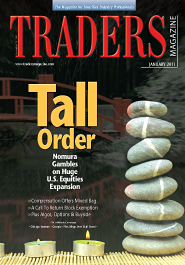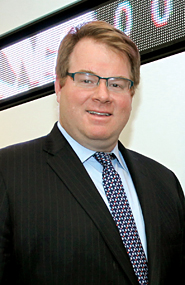These may be dog days for equities trading in America. But that hasn’t stopped Nomura Securities International from making a bold gamble with its U.S. build-up.

Japanese securities giant Nomura Holdings, of which NSI is the U.S. broker-dealer, is making its strongest push yet to establish an American presence in investment banking. The equities group represents one of four divisions Nomura Holdings has been expanding for its U.S. strategy, alongside fixed income, investment banking and asset management.
It sees America as the vital missing component to reaching its goal of becoming a global investment bank. And for its U.S. equities division, Nomura believes it now has the worldwide reach, financial heft and the right people in place to be a full-service, bulge bracket powerhouse.
Make no mistake, becoming a bulge bracket bank in the U.S. is no small feat, as skeptics have been quick to point out. And Nomura isn’t the first to attempt it. But to get to the necessary high level of market share, revenues and customer numbers in U.S. equities, Nomura said it will leverage its biggest asset. It’s pushing its global markets acumen in research and trading to a U.S. investor base whose hunger for international investments keeps growing, said Ciaran O’Kelly, Nomura’s head of equities in the Americas.
"Nomura is walking in here with a global banner," he said. "Take Asia, for example. Asia is becoming increasingly and rapidly more important to global investors. Nomura delivers Asia in a way that very few others can even think about doing."
Ramping Up
The last two years have been dramatic for Nomura’s equities U.S. group. It grew from a staff of around 50 to more than 450, including new heads of cash, sales, electronic and program trading, as well as prime services, research and convertibles. Practically from the ground up, it built program trading and equity derivatives businesses. It also launched its algo suite, crossing network, analytics, market connectivity, smart order-routing and high-frequency trading business. Its electronic desk has established more than 100 accounts. And its U.S. equities business, as a whole, claims more than 1,000 clients–of which 850 are actively trading.
All told, this has been Nomura’s biggest move into the U.S. by far. But it hasn’t been its first.
Dusting off the annals of history, Nomura opened a U.S. office in 1927. Until 2003, though, it focused mostly on marketing and distributing its research product and deal flow that originated mostly in Asia. It also did some prop trading.
In 2003, Nomura brought in a group of traders and technologists from ITG–its head of sales and trading for the western region, a former head program trader and a top algo modeler–to build a high-touch and low-touch U.S. offering. The effort failed to gain traction, though, and the group eventually merged into Instinet sometime after Nomura purchased it in February 2007.
The Instinet purchase gave Nomura an agency presence in the U.S. Initially, Tokyo had plans of marketing the two together for U.S. clients. But after the Lehman purchase and the buildup of its U.S. brokerage, Nomura Holdings decided to view the two U.S. businesses as separate, but complementary, platforms.

Nomura does not wish to concern clients over any potential conflicts of interest between Instinet’s agency-only model and its U.S. equities broker-dealer. As a result, it keeps the two headquartered in different parts of Manhattan. In addition, Instinet execs report to Tokyo, and have no dealings with O’Kelly’s equities group.
But back in 1998 and 2007, the U.S. division also hit roadblocks. Troubles with commercial mortgage-backed securities in 1998 hurt the U.S. business and triggered restructuring on a massive scale. A similar problem in 2007 with residential mortgage-backed securities forced a scale-back.
But this time Nomura is upping the ante and making the U.S. a priority. And Tokyo has backed up its decision with an enormous commitment, Nomura execs said. The firm knows the U.S. represents a huge chunk of the markets–between 40 to 50 percent of the world market capitalization in equities, according to industry estimates.
"You can’t be a true global equities house unless you have U.S. distribution," O’Kelly said.
Nomura’s approach to building this distribution has differed from those of other banks, primarily because they didn’t buy an established U.S. firm and work from its legacy technology, infrastructure and personnel. The four largest foreign banks with formidable trading operations in the U.S. all followed that course, to some degree. UBS bought Paine Webber and, by extension, Dillon Read. Credit Suisse bought First Boston. Deutsche Bank acquired Bankers Trust and, as a result, Alex. Brown & Sons. And most recently, Barclays bought Lehman Brothers’ U.S. operations.
New Attitude
The launch of Nomura’s cash and electronic trading and research offerings in the U.S. marked the culmination of a process that dates back to September 2008, when it acquired Lehman’s Asian, European and Middle Eastern operations. At a stroke, Nomura boosted its then modest efforts in Europe and the Middle East. It made its robust presence in Asia even stronger. It added around 8,000 employees, many with regional specialties in fixed income and equities. It also gave Nomura the wherewithal and momentum to accelerate its strategy to reach its global ambitions.
Attitudes in Tokyo have also undergone a transformation. Following the Lehman acquisition, Nomura overhauled its entire wholesale operations, which includes all equities trading, according to Masao Muraki, a research analyst at Deutsche Bank.
The wholesale group then implemented a U.S. investment bank management style and restructured all of its unprofitable operations outside of Japan, Muraki wrote in an October report. The changes have made Nomura’s wholesale group more competitive on a global scale, he concluded. It was too early, though, to assess how much the U.S. operations were contributing, he added.
"This bold restructuring was considerably risky, but it has gone relatively smoothly," Muraki wrote.
O’Kelly believes this effort by Nomura will be successful because it is committed to the business. Past attempts were more principal-driven–or prop shop–businesses, as opposed to the client-driven businesses it has been building.

"This is the first time Nomura has focused, as their mission, on establishing a core, client-focused U.S. institutional equities business across all product lines," he said.
Still, though the goal from the outset was ambitious, the timing could have been better.
The true catalyst to Nomura’s U.S. buildup–the Lehman acquisition–was forged in the fires of the largest financial crisis the country has seen since the Great Depression. Next, Nomura proceeded to hire staff and ramp up its front office and support infrastructure, execution technology and analytics at a time when institutions were increasingly pulling their money from the U.S. equities markets. Finally, Nomura formally launched its products and services, after many months of testing, into a world where equity trading volumes and investor confidence in equities have both diminished significantly.
Will they succeed in spite of these factors? Asked about the multi-year guarantees the firm has promised some of its staff in the face of dwindling commissions, Nomura would only say it’s been pleased with its progress and momentum across its business lines.
Among others across the industry, opinions were mixed.
A director of equity trading at a midsize institution said that Nomura’s pursuit under such difficult conditions alone is interesting. His desk does not trade with Nomura, he said, nor has it yet received overtures to do so. But, he added, Nomura’s offering will be the key to its success or struggle.
"With electronic trading, there’s always room for somebody with truly innovative ideas," he said.
Nomura’s appetite for committing capital would also find a ready audience, the institutional trader added. "In this current environment, that would be a departure from others who stopped doing that a while back," he said.
A brokerage competitor mentioned how daunting the task would be for Nomura. He cited how large foreign firms, like HSBC, among others, have tried and failed.
"In the best of times, it’d be very difficult to create a new bulge bracket player in the equities business; it’s asking a lot," he said. "If they pull it off, then they’ll be among the first."
An ATS executive and veteran industry observer said building a U.S. business takes patience and fortitude through erratic economic cycles. Successful equities businesses take decades to build, he added, not three or four years.
"You’ve got to be at it for a long time," he said. "There are going to be ups and downs and swings in there."
O’Kelly acknowledged that Nomura’s undertaking is unprecedented. He also described the experience as the most invigorating of his 21-year career.
"It is a considerable challenge," O’Kelly said. "We’re not entitled to anything, and we’re going to have to earn it every day."
O’Kelly arrived at Nomura after roughly seven years at Bank of America. He served in various executive roles, from head of global equity capital markets to head of global equities. Prior to Bank of America, O’Kelly worked for 11 years at Citigroup/Smith Barney, where he started as a position trader and departed as head of equity trading.
His experience at BofA, leading both equities and equity capital markets, gave him the opportunity to restructure a significant part of Bank of America, as well as integrate Montgomery Securities within its framework. The experience prepared him for his role at Nomura, O’Kelly said.
"Pulling in all of that experience across markets and banking, to take these companies on the road through the states, to make sure we’re introducing them to the right investors, building books of demand for these deals, pricing and successfully managing the aftermarket–that’s a huge part of my job today," he said. "That’s a huge part of the Nomura story."
And Nomura execs are confident about its chances for success.
Managing Risk
On the cash side, capital commitment is a priority, as well as a differentiator, said Paul Sangimino, who, along with Pascal Bandelier, co-heads the U.S. equity cash business at Nomura. Sangimino joined the firm this past summer after roughly two years at Citi, where he most recently ran the cash equity trading desk. For the previous 13 years, he worked at Lehman in the U.S.
"We consider capital commitment and risk to be integral parts of our core competencies," he said. "As a result of our ability to price and manage risk, our clients feel comfortable coming to us."
Kevin Brady, who heads Nomura’s program trading in the U.S., said clients will come to value the firm’s new structure, as well. Unlike some global investment banks, Nomura’s business lines aren’t siloed off from one another, he said. As a result, many corporate services and information are often shared across divisions.
"From day one, we’ve tried to create a very silo-free structure, which is doable, partially because there’s no legacy platform to unwind," he said. "You’ll find here that across the room, there’s a lot more information sharing across the U.S. desks and regions, which lends itself to a more coordinated and global approach."
Lead With Research
In addition, Nomura’s electronic platform for its Asian and European businesses is built on the same framework in New York. This improves the firm’s ability to create and distribute global products. Nomura also picked sales traders and traders who could service clients with multiple products, Brady said, such as one who could help trade a single-stock order and the option on that order.
Brady joined the firm in November 2008 from Barclays Capital, after about seven years at Lehman Brothers, where he focused on global program trading. He remembers the first month on the job as a daunting experience, considering the scale of what Nomura was trying to do. Looking back on all the work has been gratifying, though.
"We’re where we thought we’d be," Brady said. "We took a very incremental approach, where we wanted to have deliverable two months out, four months out, six months out. We’ve been able to stick to that schedule pretty rigorously."
Initially, without research, Nomura’s U.S. desk serviced a small range of clients. Most were execution-only or quantitative in nature, seeking low-cost providers and not looking for fundamental research.
"We played where we could, initially," Brady said. "Now, the research offering has opened up a lot of doors for clients who need U.S. research, where we need to get U.S. votes to get onboard with them."
Since October, Nomura has offered fundamental research from a team of eight analysts. This includes Brian Foran from Goldman Sachs, Glenn Schorr from UBS and Michael Nathanson from Sanford C. Bernstein. The team has concentrated on financials, media, telecom and consumer sectors. For 2011, Nomura will go deeper in each of those sectors, as well as expand the breadth of the platform, O’Kelly said.
"We lead with research, for being an ideas house," he added.
U.S. analysts cover 91 stocks. But Nomura’s three-year goal is to have 500 stocks under coverage in the U.S. and 30 published analysts. Internationally, Nomura covers an additional 1,859 stocks.
Nomura is concerned about profitability, but not at the expense of building a business. Ultimately, when Nomura finishes its build-out, success will be measured in profitability, O’Kelly said. And he expects the U.S. equities business to be profitable sometime this year, he added.
Nomura Holdings does not break out revenues for its Americas equities group in its financial filings. According to the Form 6-K it filed for the Securities and Exchange Commission in November, net revenues for the Americas group were up 21 percent for the first six months of its 2010 fiscal year ending Sept. 30 over the same period in 2009.
For their part, no one at Nomura needs to look far to be reminded of the spirit of an unprecedented incremental build. Seated in the new 75,000-square-foot trading room on the sixth floor of 2 World Financial Center, one has only to glance outside the eastern windows to see new buildings rise and the World Trade Center Memorial take shape at Ground Zero. Those closest to the windows can even hear the steady pounding, hammering and drilling of the construction equipment and crew.
The past aside, Nomura is optimistic. It’s certain it will reach these goals, including its push to join the bulge bracket ranks.
"There are a lot of other firms in 2010 that are trying to penetrate the U.S. equities markets," Sangimino said. "But they don’t have nearly the breadth or the global reach or the platform and the strengths that Nomura has."
(c) 2011 Traders Magazine and SourceMedia, Inc. All Rights Reserved.
http://www.tradersmagazine.com http://www.sourcemedia.com/




